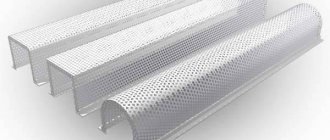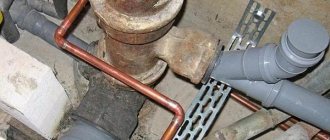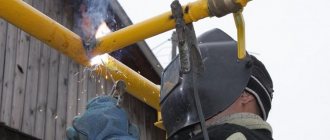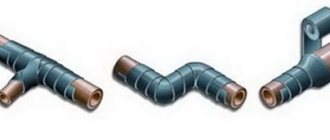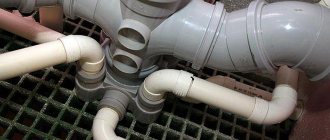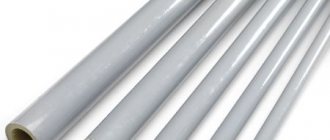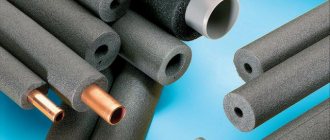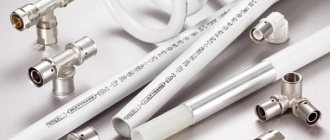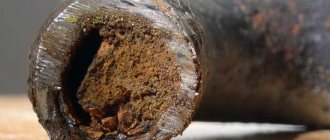Weight of electric welded steel pipe. Table
Electric welded pipe GOST 10704-91 is made of carbon and low-alloy steel. The principle of its manufacture is the formation of a sheet or strip and subsequent robotic welding using a single seam. Several types of welding are used: arc, laser, plasma and induction currents.
Afterwards, the welding seam undergoes mandatory processing. The main advantage of this type of production is that it is possible to produce various cross-sectional shapes of electric-welded pipes: round, oval, square, rectangular.
Figure 1. Oval Figure 2. Square Figure 3. Rectangular
electric welded pipe. electric welded pipe. electric welded pipe.
There are electric welded pipes with a straight seam (straight-seam) and with a seam in the form of a spiral (spiral-seam).
Figure 4. Electric welded Figure 5. Electric welded pipe
straight-seam pipe. spiral suture
If the pipe is a straight-seam steel pipe , then you can calculate the width of the strip or sheet by multiplying the number π (3.14) by its diameter. Particular attention should be paid to the diameter, namely whether it is external or internal. If the diameter is internal, then when unfolding, you need to add a value equal to the thickness of the sheet to its width.
Electric-welded pipes are standardized in length sizes ranging from 4 to 12 meters.
Its use has found application in various fields of human activity. Such pipes are used to make construction and mechanical engineering structures, water supply lines, etc.
The weight of electric-welded pipes differs from the weight of seamless pipes and is standardized by GOST.
Table of internal and external diameters of pipes.
Today, tables of diameters of steel pipes are relevant for the reason that in almost all areas of construction pipes made of different types of plastic and metal are used. In order to easily understand this variety of materials and learn how to combine them, regulatory documents have been developed, such as tables of steel pipe diameters and their correspondence to polymer pipes. To calculate the weight of a pipe or the length of a pipe, you can use a pipe calculator.
Table of diameters of steel and polymer pipes.
Outer diameter (Dh), pipes, in mm according to GOST and DIN / EN
Pipe outer diameter D, mm
Nominal diameter (DN, Dy) is the nominal size (in millimeters) of the internal diameter of the pipe or its rounded value, in inches.
The nominal diameter is the rounded nominal size of the internal diameter. It is always rounded up only. The nominal diameter of steel pipes is determined by GOST 355-52.
Symbols and GOSTs:
- DIN / EN – the main European standard for steel pipes according to DIN2448 / DIN2458
- Steel water and gas pipes – GOST 3262-75
- Electric-welded steel pipes – GOST 10704-91
- Seamless steel pipes GOST 8734-75 GOST 8732-78 and GOST 8731-74 (from 20 to 530 mm).
Classification of steel pipes by outer diameter (Dн).
10; 10,2; 12; 13; 14; (15); 16; (17); 18; 19; 20; 21,3; 22; (23); 24; 25; 26; 27; 28; 30; 32; 33; 33,7; 35; 36; 38; 40; 42; 44,5; 45; 48; 48,3; 51; 53; 54; 57; 60; 63,5; 70; 73; 76; 88; 89; 95; 102; 108.
114; 127; 133; 140; 152; 159; 168; 177,8; 180; 193,7; 219; 244,5; 273; 325; 355,6; 377; 406,4; 426; (478); 530.
530; 630; 720; 820; 920; 1020; 1120; 1220; 1420.
The small outer diameter of steel pipes is used for the construction of water supply systems in apartments, houses and other premises.
Medium diameter steel pipes are used in the construction of municipal water pipelines, as well as in industrial crude oil collection systems.
Large-diameter steel pipes are needed for the construction of main gas and oil pipelines.
Pipe internal diameter standard.
There is a standard for the internal diameter of pipes, which is accepted in most countries of the world. The internal diameter of pipes is measured in millimeters. The following are the most common internal pipe diameters:
The internal diameter of steel pipes is designated (Din). There is also a certain standard for the diameter of pipes, it is designated by the term “nominal bore (diameter)”. It is designated Dу.
The internal diameter of the pipe can be calculated using the following formula: Din = Dn - 2S.
Electric welded pipe dimensions table weight
Electric-welded straight-seam steel pipes (GOST 10704-91)
- with a diameter of up to 30 mm - at least 2 m
- with a diameter over 30 to 70 mm - at least 3 m
- with a diameter over 70 to 152 mm - at least 4 m
- with a diameter over 152 mm - no less than 5 m
- at the request of the consumer, pipes of groups A and B according to GOST 10705 with a diameter of over 152 mm are manufactured with a length of at least 10 m
- pipes of all groups with a diameter of up to 70 mm - a length of at least 4 m;
- with a diameter of up to 70 mm - from 5 to 9 mm
- with a diameter over 70 to 219 mm - from 6 to 9 m
- with a diameter over 219 to 426 mm - from 10 to 12 m
GOSTs and specifications for rolled pipes
The produced range, dimensions, characteristics and use of rolled pipe products are regulated by state standards (GOST) and technical conditions (TU).
For electric welded pipes
- GOST 3262-75 — Steel water and gas pipes.
- GOST 10704-91 — Electric-welded straight-seam steel pipes. Assortment
- GOST 10705-80 — Electric-welded steel pipes. Specifications
- GOST 10706-76 — Electric-welded straight-seam steel pipes. Technical requirements
- GOST 20295-85 — Welded steel pipes for main gas and oil pipelines
For seamless pipes
- GOST 8731-74 — Seamless hot-deformed steel pipes. Technical requirements
- GOST 8732-78 — Seamless hot-deformed steel pipes. Assortment
- GOST 8733-74 — Cold-deformed and heat-deformed seamless steel pipes. Technical requirements
- GOST 8734-75 — Seamless cold-deformed steel pipes. Assortment
- TU 14-3-460-2009 — Seamless steel pipes for steam boilers and pipelines. Specifications
- TU 14-3R-55-2001 — Seamless steel pipes for steam boilers and pipelines. Specifications
- GOST 9940-81 — Seamless hot-deformed pipes made of corrosion-resistant steel. Specifications
- GOST 9941-81 — Cold- and heat-deformed seamless pipes made of corrosion-resistant steel. Specifications
- GOST 9567-75 — Precision steel pipes. Assortment
For profile pipes
- GOST 8639-82 — Square steel pipes. Assortment
- GOST 8645-68 — Rectangular steel pipes. Assortment
- GOST 13663-86 — Profile steel pipes. Technical requirements
- GOST 30245-2003 — Bent closed welded square and rectangular steel profiles for building structures. Specifications
- TU 14-105-737-2004 — Electric-welded straight-seam steel pipes of round and profile sections. Specifications
Steel pipe diameters
The diameter of a steel pipe is determined by the outer diameter for electric-welded and seamless pipes, and for VGP - by the nominal diameter (often designated as DN). That is, the internal diameter of the pipes is Dу, the outer diameter of the pipes is Dн
, thread diameter - G. Pipe sizes are determined in millimeters, but VGP pipes are often designated in inches (“”).
VGP pipe size (GOST 3262-75)
Main pipe dimensions: 15 mm (1/2″ inch); 20 mm (3/4″); 25 mm (1″); 32 mm (1 1/4″ inches and a quarter); 40 mm (1 1/2″); 50 mm (2″). There are also the following DNs: 10 mm, 65 mm, 80 mm, 90 mm, 100 mm and even 125 mm - but they are rarely used and, as a rule, are replaced by other types of steel pipes (for example, electric welded). Most often, 3/4″ pipes are used for risers, and 1/2″ for internal wiring.
Electrical pipes (GOST 10704-91)
E/s straight-seam pipes come in the following outer diameters (in millimeters): 10; 12; 13; 14; 16; 17; 17.5; 18; 19; 20; 21.3; 22; 24; 25; 26; 28; thirty; 32; 33; 33.7; 36; 38; 40; 42; 43; 45; 48; 51. For diameters up to 57 mm, a VGP pipe of the appropriate size is used. The most popular are straight-seam pipes in accordance with GOST 10704-91 with sizes of 57 mm and above. Their main diameters: 57; 60; 63.5; 76; 89; 102; 108; 114; 127; 133; 140; 146; 159; 168; 178; 193; 219; 245; 273; 325; 377; 426; 530.
Welded pipes for gas and oil pipelines (GOST 20295-85)
They start with a diameter of 159 mm and up to 530 mm come with the same dimensions as pipes according to GOST 10704-91. Basic larger diameters (in millimeters): 630, 720, 820, 1020,1220, 1420.
Size of hot-rolled seamless pipes (GOST 8732-78)
Commonly used diameters of seamless hot-formed pipes (mm): 32; 38; 42; 45; 51; 54; 57; 60; 63.5; 68; 70; 73; 76; 83; 89; 95; 102; 108; 114; 121; 127; 133; 140; 146; 152; 159; 168; 180; 194; 203; 219; 245; 273; 325; 351; 426.
Manufacturers can produce any pipe sizes according to customer requirements.
Pipe internal diameters
According to the standard series adopted in most countries, pipes have the following internal diameters, measured in mm: 6, 10, 15, 20, 25, 32, 40, 50, 65, 80, 100, 125, 200, etc.
A system of measuring thread diameter in inches is also used. 1″ = 25.4 mm.
The table shows pipe sizes (diameters) in mm and inches:
| Nominal pipe bore (Dy) mm | Thread diameter (G), inch | Pipe outer diameter (Dн), mm | ||
| Steel water and gas pipe | Seamless | Polymer | ||
| 10 | 3/8″ | 17 | 16 | 16 |
| 15 | 1/2″ | 21,3 | 20 | 20 |
| 20 | 3/4″ | 26,8 | 26 | 25 |
| 25 | 1″ | 33,5 | 32 | 32 |
| 32 | 1 1/4″ | 42,3 | 42 | 40 |
| 40 | 1 1/2″ | 48 | 45 | 50 |
| 50 | 2″ | 60 | 57 | 63 |
| 65 | 2 1/2″ | 75,5 | 76 | 75 |
| 80 | 3″ | 88,5 | 89 | 90 |
| 90 | 3 1/2″ | 101,3 | 102 | 110 |
| 100 | 4″ | 114 | 108 | 125 |
| 125 | 5″ | 140 | 133 | 140 |
| 150 | 6″ | 165 | 159 | 160 |
When installing a system of steel pipes for residential buildings, pipes with an internal diameter size of Dу = 15, 20 and 32 mm are usually used.
Cast iron non-pressure pipes with diameter Dу = 50 and 100 mm are the most commonly used.
Currently, pipes made of polymer materials are increasingly used for laying intra-house pipelines, which are replacing cast iron and steel.
It should be noted that depending on the type of material used in the manufacture of pipes, different designation systems are used. In most cases, steel and cast iron pipes are designated by nominal diameter or internal diameter. Copper pipes, some types of steel pipes, and pipes made of polymer materials are designated by their outer diameter. Therefore, you should be careful when choosing the required pipe, and also take into account the wall thickness.
Pipe outer diameters and pipe wall thickness
| Outer diameter, Dн mm | Wall thickness, mm | ||
| Steel water and gas pipes GOST 3262-75 | |||
| 15 | 2,8 | ||
| 20 | 2,8 | ||
| 25 | 3,2 | ||
| 32 | 3,2 | ||
| 40 | 3,5 | ||
| 50 | 3,5 | ||
| Electric welded steel pipes GOST 10704-91 GOST 10705-80 | |||
| 57 | 3,5 | ||
| 76 | 3,5 | ||
| 89 | 3,5 | 4,0 | |
| 102 | 3,5 | 4,0 | |
| 108 | 3,5 | 4,0 | |
| 114 | 4,0 | 4,5 | |
| 133 | 4,0 | 4,5 | |
| 159 | 4,5 | 5,0 | 6,0 |
| Plastic pipes | |||
| 10 | 2,0 | ||
| 1,7 | |||
| 1,4 | |||
| 1,2 | |||
| 1,0 | |||
| 0,8 | |||
| 0,6 | |||
| 0,5 | |||
| 0,5 | |||
| 12 | 2,4 | ||
| 2,0 | |||
| 1,7 | |||
| 1,4 | |||
| 1,1 | |||
| 0,9 | |||
| 0,8 | |||
| 0,6 | |||
| 0,6 | |||
| 0,5 | |||
| 0,5 | |||
| 16 | 3,3 | ||
| 2,7 | |||
| 2,2 | |||
| 1,8 | |||
| 1,5 | |||
| 1,2 | |||
| 1,0 | |||
| 0,8 | |||
| 0,7 | |||
| 0,7 | |||
| 0,6 | |||
| 0,5 | |||
| 20 | 4,1 | ||
| 3,4 | |||
| 2,8 | |||
| 2,3 | |||
| 1,9 | |||
| 1,5 | |||
| 1,2 | |||
| 1,0 | |||
| 0,9 | |||
| 0,8 | |||
| 0,7 | |||
| 0,7 | |||
| 0,5 | |||
| 25 | 5,1 | ||
| 4,2 | |||
| 3,5 | |||
| 2,8 | |||
| 2,3 | |||
| 1,9 | |||
| 1,5 | |||
| 1,2 | |||
| 1,1 | |||
| 1,0 | |||
| 0,9 | |||
| 0,8 | |||
| 0,7 | |||
| 0,5 | |||
| 32 | 6,5 | ||
| 5,4 | |||
| 4,4 | |||
| 3,6 | |||
| 2,9 | |||
| 2,4 | |||
| 1,9 | |||
| 1,6 | |||
| 1,4 | |||
| 1,3 | |||
| 1,1 | |||
| 1,0 | |||
| 0,8 | |||
| 0,7 | |||
| 0,5 |
Dimensions of plastic sewer pipes
Nowadays, plastic pipes have replaced the former cast iron and metal sewer pipes. They are gradually replacing old materials for sewerage installation from use, as they have better technical characteristics.
The advantages of plastic sewer pipes include:
- simplicity and speed of installation: they are easy to cut and connect;
- light weight: easy to transport and move, installation can be easily handled by one person;
- impossibility of damage from corrosion and the absence of roughness on the inside of the pipes, on which decomposition products can gradually build up;
- durability: the manufacturer guarantees a fifty-year service life for plastic sewer pipes, and in reality they will last longer.
- cheap: compared to cast iron and metal, plastic pipes cost mere pennies.
The disadvantages of plastic sewer pipes include:
- increased noise compared to cast iron: this is felt in panel apartment buildings with high sound permeability;
- sensitivity to high temperatures: when the temperature inside the pipe is above ninety degrees, the pipe gradually softens and deforms. But in the sewer system, as a rule, such high temperatures are not created for a long time.
Standards and range
The parameters and dimensions of plastic sewer pipes depend on their area of application - whether it is an internal pipe or an external one. The outer ones have greater wall thickness, and, consequently, strength. Plastic pipes differ in the material from which they are made:
- Pipes made of polypropylene (PP), the most common option, are produced in accordance with GOST 26996-86, which determines the composition of PP and copolymers. GOST does not establish a specific standard for them “plastic sewer pipes sizes”. But in a market economy, the standard sizes of PP pipes have developed independently: the following diameters of sewer plastic pipes are on sale: 32, 40, 50 and 110 mm; length options: 150, 250, 500, 750, 1000, 2000 and 3000 mm.
- Pipes made of high-density polyethylene (HDP) are produced in accordance with GOST 22689.2-89. Since they are produced wound into coils and cut into pieces of any desired length, GOST establishes only their diameters: 40.50, 90 and 110 mm. PVP pipes are divided into pressure and non-pressure. For pressure pipes, GOST 18599-83 prescribes the diameter of sewer plastic pipes from 10 to 1200 mm.
- Polyvinyl chloride (PVC) pipes. The dimensions of this type of plastic sewer pipe are established by GOST 51613-2000. According to his instructions, PVC pipes should be from 10 to 315 mm in diameter, with a length of 4 to 12 m.
